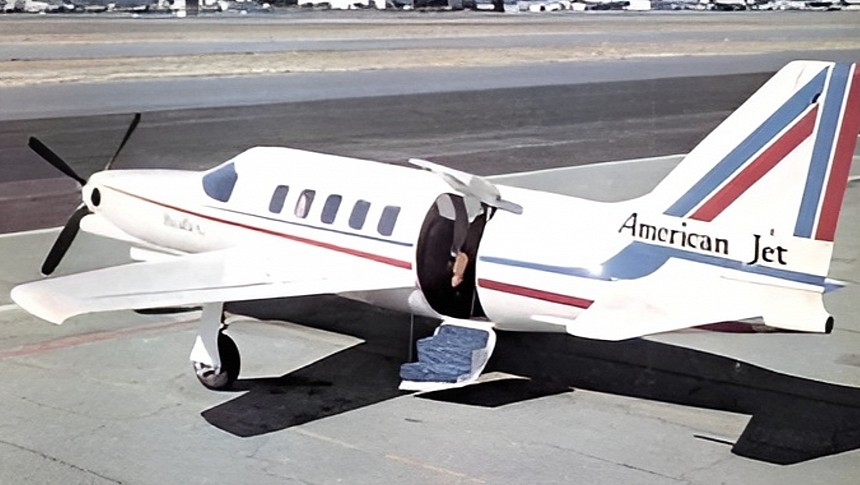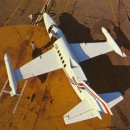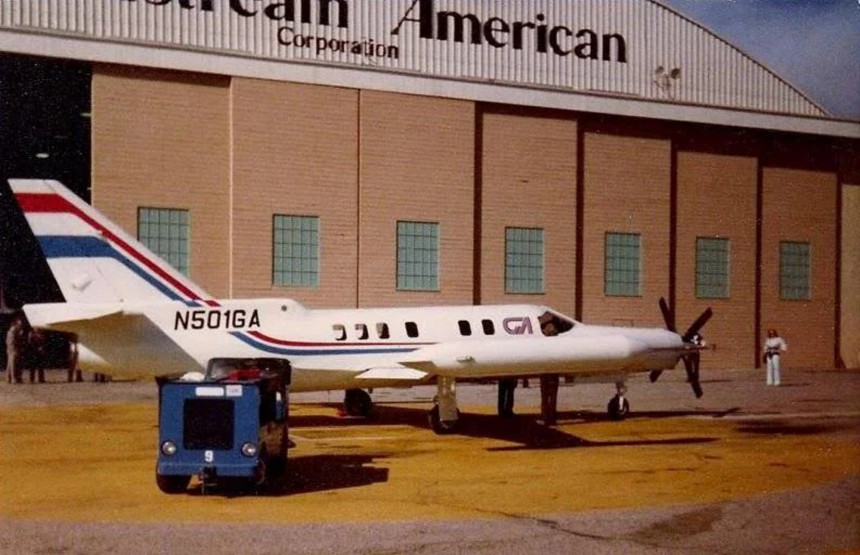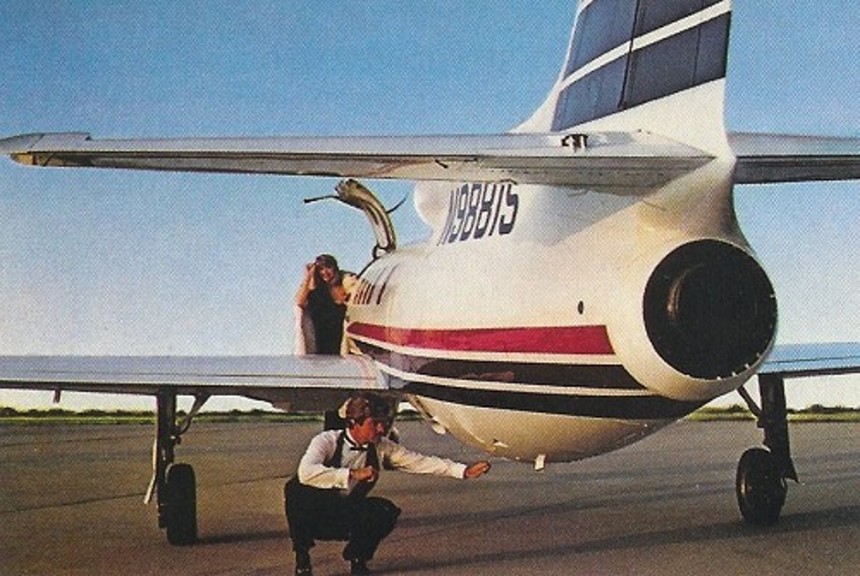You know what multi-millionaire American business tycoons needed more than anything in the 80s? Besides luxury condos in NYC's Upper West Side, it was wacky, eye-catching business jets. What better way to flaunt your bank account than by flying a private business jet that's faster, more luxurious, and more unique than your hedge-fund buddies? Since the market for such planes is no joke, a short-lived partnership between Gulfstream and American Jet Industries was there to give the bankers and celebrities what they wanted.
This is the story of the Gulfstream American Hustler, a turboprop-turbofan mixed power business jet that could have only been designed in the United States in the 70s and 80s. A time where, just like Gordon Gekko said, greed was good, and greed worked. Timeless movie quotes aside; there was some serious industry horsepower behind the drive to make an all-new breed of business jet. One capable of taking off from short municipal airport runways with its turboprop engine and cruising close to 40,000 feet with its turbojet. It took a complete restructuring of one of America's premiere VIP business jet manufacturers to get the ball rolling on such an ambitious project.
Gulfstream themselves began as a wholly-owned subsidiary of the Bethpage, New York-based Grumman Aerospace Corporation, manufacturing the original Grumman Gulfstream G-1 turboprop business plane. After considerable success, Grumman formally separated its business jet operation from the military side of things, moving its business jet workforce to Savanah, Georgia, in 1967 in preparation to build the turbofan-powered Gulfstream II. Six years later, in 1973, Grumman merged its civil aviation division with another of its corporate subsidiaries, American Aviation Corporation, before selling the whole thing off to a conglomerate known as American Jet Industries (AJI) in 1974 to form Gulfstream American.
This sale put the assets of Gulfstream in the hands of someone who wanted to spit in the face of tradition and established business jet designs. A man by the name of Allen Paulson. After two decades working as one of the most prolific second-hand civil airliner salesmen in North America, no sooner was the Gulfstream's sale to AJI finalized than Paulson began designing this novel hybrid business jet. Had all gone to plan, Paulson aimed to send the jet into production by the turn of the 1980s, perhaps even a bit earlier if it was possible. Initially, there was debate among Gulfstream American engineers as to whether Paulson's design qualified as a single-engine airplane with a turbojet emergency power unit or a dedicated twin-engine aircraft.
Ultimately, it was decided to certify what became known as the Hustler as a twin-engine business jet with the Federal Aviation Administration (FAA). The final agreed-upon design was something never before attempted outside of dedicated military aircraft like the Ryan XF2R Dark Shark. With dimensions of 12.57 m long (41 ft 3 in) long and a 10.49-meter (34 ft 5 in) wingspan, and a capacity for between five and seven passengers, the Hustler was considerably smaller than the more traditional Gulfstream II and III. Instead, being sized more in line with smaller private aircraft like the modern Cessna Grand Caravan EX.
By looking at just the front fascia alone, it's almost easy to think the Hustler was just another private business plane. But clues to this strange chimera of a business jet can be found by observing the prominent turbojet air intake mounted in front of the Hustler's tail section. In its initial form, the Hustler 400, the prototype was powered by a single Pratt & Whitney Canada PT6A-41 turboprop in the nose making 900 shaft hp (670 kW). Most famous for its use in the Beech King Air and the above-mentioned Cessna Caravan, the PT6 is still one of the most prolific turboprops ever designed.
At the rear, behind the unmistakable air intake, sat a Pratt & Whitney Canada JT15D-1 turbojet engine most well known for its use in the Cessna Caravan twin-jet and the Aermacchi S-211 military trainer and jetting 2,200 lbf (9.8 kN) thrust. In theory, this powertrain was good for a takeoff run to 50 feet (15m) of 1,745 ft (532 m),m and an impressive rate of climb of 4,950 ft/min (25.1 m/s). At the top end, Gulfstream American aimed for the Hustler to cruise at 400 miles per hour (400 kn, 740 kph) and at a maximum altitude of 38,000 ft (12,000 m) over a distance of at least 2,000 nautical miles (2,300 mi, 3,700 km). That's not bad at all in terms of performance, even almost 45 years later.
Inside the pressurized cabin, luxurious leather-stitched seating for either five or seven passengers melded with a generously-sized, built-in refreshment center and a full private bathroom. A separate baggage area with 30 cubic feet of cargo storage was also an excellent utilization of every square inch of the Hustler's airframe. With all the pieces in place, the sole existing Hustler 400 prototype left American Jet's 40-acre facility in Van Nuys, California, on January 11, 1978. At the controls that day was Allen Paulson himself, who found the flight characteristics of his novel airplane to be to his liking. Still, there was room for improvement.
With little more than 30 hours logged on the flight clock, the Hustler 400 was wheeled back to its California hangar for some performance upgrades. First up was replacing its Pratt & Whitney Canada turboprop engine for a beefier Garrett TPE331 unit, most notable for its use in the Short Tucano military trainer and the General Atomics MQ-9 Reaper UAV. Re-worked air intake ducting and added wing-tip fuel tanks essentially turned the only Hustler into an entirely new airframe, now dubbed the Hustler 500. With all the necessary adjustments made, it looked as though Gulfstream American would begin manufacturing and selling Hustler business jets as soon as the 1980s were underway.
Instead, projected cost overruns and a company-wide dedication to completing Gulfstream's real money maker, the Gulfstream III, saw the quirky and unproven Hustler 500 knocked down the team's priority list in a hurry. That didn't stop Gulfstream from accepting as many as 76 down payments from prospective customers before a second example was ready. Predictably, this influx of deposit more was more or less just wishful thinking on the part of Gulfstream American and its customers. Not long after the Hustler 500's first test flight on January 26, 1981, the had still failed to achieve its FAA flight certification, and the program was subsequently ended entirely before the end of that year.
The Gulfstream American Hustler never carried a single paying passenger in either its 400 or 500 forms. But that wouldn't stop the company that built it from squeezing as much life out of its airframe as possible. Proposals to market the Hustler airframe to the U.S. Air Force during development ultimately evolved into an all-new design for Air Force's Next Generation Trainer (NGT) program called the Peregrine 600. Interestingly, the Peregrine 600 program would lose out to the Fairchild T-46 in the NGT program, prompting the design to move back into the civilian business jet space and was known as the Fanjet 1500, and finally, the Gulfstream Peregrine.
Of course, this means that all three airframes trialed on the Gulfstream American Hustler platform never saw production. One can only fathom how much money was spent in this pursuit, only for the final crescendo to never take place. If not for the avalanche-like success of the firm's more traditional business jets like the Gulfstream III through V and later the G450 and G550, it's anyone's guess whether Gulfstream would still be kicking around today. Thankfully for the folks of Savannah, Georgia, the Hustler platform wound up being a mere footnote in a company history riddled with sales to the global elite. For that reason, looking back on the failure of the Hustler is more of a humorous curiosity rather than a tragedy.
Gulfstream themselves began as a wholly-owned subsidiary of the Bethpage, New York-based Grumman Aerospace Corporation, manufacturing the original Grumman Gulfstream G-1 turboprop business plane. After considerable success, Grumman formally separated its business jet operation from the military side of things, moving its business jet workforce to Savanah, Georgia, in 1967 in preparation to build the turbofan-powered Gulfstream II. Six years later, in 1973, Grumman merged its civil aviation division with another of its corporate subsidiaries, American Aviation Corporation, before selling the whole thing off to a conglomerate known as American Jet Industries (AJI) in 1974 to form Gulfstream American.
This sale put the assets of Gulfstream in the hands of someone who wanted to spit in the face of tradition and established business jet designs. A man by the name of Allen Paulson. After two decades working as one of the most prolific second-hand civil airliner salesmen in North America, no sooner was the Gulfstream's sale to AJI finalized than Paulson began designing this novel hybrid business jet. Had all gone to plan, Paulson aimed to send the jet into production by the turn of the 1980s, perhaps even a bit earlier if it was possible. Initially, there was debate among Gulfstream American engineers as to whether Paulson's design qualified as a single-engine airplane with a turbojet emergency power unit or a dedicated twin-engine aircraft.
Ultimately, it was decided to certify what became known as the Hustler as a twin-engine business jet with the Federal Aviation Administration (FAA). The final agreed-upon design was something never before attempted outside of dedicated military aircraft like the Ryan XF2R Dark Shark. With dimensions of 12.57 m long (41 ft 3 in) long and a 10.49-meter (34 ft 5 in) wingspan, and a capacity for between five and seven passengers, the Hustler was considerably smaller than the more traditional Gulfstream II and III. Instead, being sized more in line with smaller private aircraft like the modern Cessna Grand Caravan EX.
At the rear, behind the unmistakable air intake, sat a Pratt & Whitney Canada JT15D-1 turbojet engine most well known for its use in the Cessna Caravan twin-jet and the Aermacchi S-211 military trainer and jetting 2,200 lbf (9.8 kN) thrust. In theory, this powertrain was good for a takeoff run to 50 feet (15m) of 1,745 ft (532 m),m and an impressive rate of climb of 4,950 ft/min (25.1 m/s). At the top end, Gulfstream American aimed for the Hustler to cruise at 400 miles per hour (400 kn, 740 kph) and at a maximum altitude of 38,000 ft (12,000 m) over a distance of at least 2,000 nautical miles (2,300 mi, 3,700 km). That's not bad at all in terms of performance, even almost 45 years later.
Inside the pressurized cabin, luxurious leather-stitched seating for either five or seven passengers melded with a generously-sized, built-in refreshment center and a full private bathroom. A separate baggage area with 30 cubic feet of cargo storage was also an excellent utilization of every square inch of the Hustler's airframe. With all the pieces in place, the sole existing Hustler 400 prototype left American Jet's 40-acre facility in Van Nuys, California, on January 11, 1978. At the controls that day was Allen Paulson himself, who found the flight characteristics of his novel airplane to be to his liking. Still, there was room for improvement.
With little more than 30 hours logged on the flight clock, the Hustler 400 was wheeled back to its California hangar for some performance upgrades. First up was replacing its Pratt & Whitney Canada turboprop engine for a beefier Garrett TPE331 unit, most notable for its use in the Short Tucano military trainer and the General Atomics MQ-9 Reaper UAV. Re-worked air intake ducting and added wing-tip fuel tanks essentially turned the only Hustler into an entirely new airframe, now dubbed the Hustler 500. With all the necessary adjustments made, it looked as though Gulfstream American would begin manufacturing and selling Hustler business jets as soon as the 1980s were underway.
The Gulfstream American Hustler never carried a single paying passenger in either its 400 or 500 forms. But that wouldn't stop the company that built it from squeezing as much life out of its airframe as possible. Proposals to market the Hustler airframe to the U.S. Air Force during development ultimately evolved into an all-new design for Air Force's Next Generation Trainer (NGT) program called the Peregrine 600. Interestingly, the Peregrine 600 program would lose out to the Fairchild T-46 in the NGT program, prompting the design to move back into the civilian business jet space and was known as the Fanjet 1500, and finally, the Gulfstream Peregrine.
Of course, this means that all three airframes trialed on the Gulfstream American Hustler platform never saw production. One can only fathom how much money was spent in this pursuit, only for the final crescendo to never take place. If not for the avalanche-like success of the firm's more traditional business jets like the Gulfstream III through V and later the G450 and G550, it's anyone's guess whether Gulfstream would still be kicking around today. Thankfully for the folks of Savannah, Georgia, the Hustler platform wound up being a mere footnote in a company history riddled with sales to the global elite. For that reason, looking back on the failure of the Hustler is more of a humorous curiosity rather than a tragedy.












